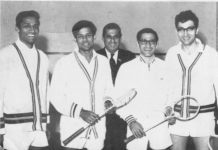By Jay D. Prince
In the United States, sports is a tremendous part of our culture. From the time we could walk, we have been playing games, informally at first but, for many, it didn’t take long before we started playing for organized teams and/or associations.
I started playing tennis at the ripe old age of four. It was only three years before I joined the United States Tennis Association and played my first tournament.
I also played soccer and baseball. I played for club teams, for my high school, and ultimately attempted to walk-on to the baseball team at UC Berkeley. Sadly, I wasn’t good enough to compete at the then Pac-10 level, but I did continue with the game by playing intramural softball. I found squash and lacrosse at Cal too, and ultimately played intercollegiately in both.
The operative phrase regarding my baseball life in college is: I wasn’t good enough. Not at Cal or, perhaps, any other Pac-10 school. Maybe I could have pursued the game at other universities, but that really wasn’t my mission in life.
In this country, there are clear pinnacles of athletic achievement. Varsity sports in high schools, the intercollegiate level, and the professional level. At each level, the criteria for admission is being good enough to compete.
When it comes to college athletics, it never occurred to me to consider the notion that American colleges and universities should be expected to reserve spots on their teams for Americans. I never pondered the question of whether or not a spot on the baseball team at Cal, that might have had my name on it, could have been taken by a kid from, say, South America. I mean, why would I have thought about that? College athletics is a privilege, not a right of citizenship. You sink or swim on your abilities, not your heritage.
It wasn’t until I started following college squash more closely, after launching this publication, that I ever addressed the American versus foreign players issue in the college game. Needless to say, the issue has risen in awareness since Trinity College—and others trying to keep up—really started pursuing international players. That pursuit was founded on the premise that the best players in the world were foreign. Guess what people, they still are. Yes, we are catching up, but we have a long way to go. Personally, I find it shameful that anyone in today’s American society would cry foul over the growing numbers of international players on American college squash teams. It’s competition, pure and simple. To be the best, you have to be able to beat the best.
The College Squash Association (CSA) is not governed by the National Collegiate Athletic Association (NCAA), but the CSA officially follows NCAA rules regarding eligibility of its athletes.
In 2004, the NCAA produced a Strategic Plan outlining the Association’s core ideology, purpose and values. Listed third among its core values is the following statement: “The Association…shares a belief in and commitment to…the pursuit of excellence in both academic and athletics.”
The NCAA Strategic Plan refers to academic and athletic excellence with regularity. But I have yet to find any “qualifiers” suggesting that American academic institutions promote opportunities for Americans over international competitors.
Throughout our society, there is always competition, whether in business, sports or anything else. College teams are in constant competition for the best players. We see that play out publicly every year on “National Letter of Intent” day when high school football players officially commit to a particular school.
Instead of looking for guarantees of matriculating to the best college squash schools because you’re American, why not focus on being the best player for the spot?





